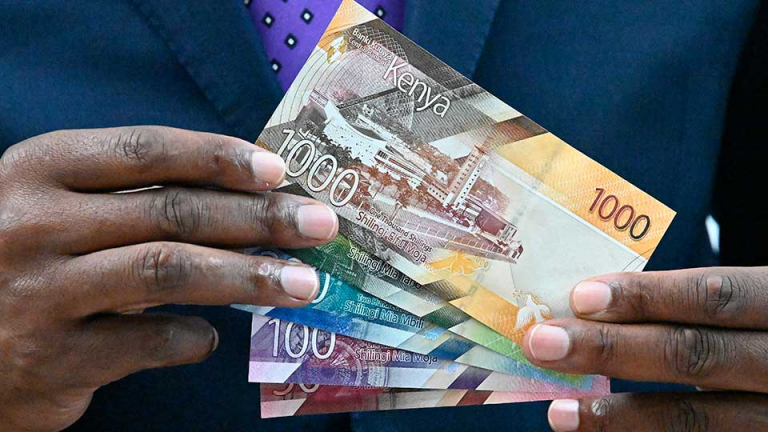Kenya’s Debt Decline Is a Currency Illusion, Not Fiscal Relief
Kenya’s KSh 41 billion debt “reduction” reflects currency valuation, not fiscal progress. As the shilling (USD/KES ≈ 129.2) firmed slightly, external debt looked smaller in local terms—but real liabilities remain unchanged, exposing an illusion of relief amid high yields.

Kenya’s reported KSh 41 billion reduction in public debt is less a fiscal victory than a valuation illusion. The National Treasury attributes the decline—bringing the total debt stock to roughly KSh 11.1 trillion—to the shilling’s recent stability, yet a closer look shows the “relief” stems from currency denomination effects rather than lower borrowing or repayments.
Nearly two-thirds of Kenya’s external liabilities—about 66 percent—are denominated in U.S. dollars, 20 percent in euros, 5 percent in yen, 4 percent in yuan, and the remainder in pounds and other currencies. When the shilling (USD/KES ≈ 129.2) firmed modestly against the euro and yen—by about 4 percent—its domestic-currency valuation of external debt fell by roughly KSh 40–45 billion, or 1 percent of the total stock. The same amount of debt still exists in hard currency; only the conversion value changed.
This is not fiscal consolidation—it is optics. A reversal in global markets could wipe out the gain overnight. With the U.S. 10-year yield (^TNX ≈ 4.35 percent) and the Dollar Index (DXY: DX-Y.NYB ≈ 105.7) remaining elevated, a stronger dollar would re-inflate Kenya’s debt ratio. The experience mirrors Ghana’s 2021 “debt reprieve” and Egypt’s 2020 balance-sheet adjustment—temporary valuation dips that vanished once the dollar cycle turned.
The fundamentals remain heavy. External debt stands near USD 44.5 billion (≈ KSh 5.7 trillion), while domestic obligations account for about KSh 5.4 trillion. The overall debt ratio hovers near 70 percent of GDP—far from the fiscal-rule target of 55 percent. Local borrowing costs stay high, with the 10-year Treasury yield (KN10Y ≈ 15 percent) and the 364-day T-bill (≈ 15.3 percent) reflecting investor caution. Kenya’s 2032 Eurobond (KE2032 ≈ 9.1 percent YTM) and 2034 (KE2034 ≈ 9.3 percent) show similar stress premiums across the curve.
The shilling’s short-term stability is policy-driven, not market-driven. The Central Bank of Kenya (CBK) has deployed open-market operations, tightened reserve requirements, and limited FX liquidity to stem volatility. Those measures curb speculation but compress private-sector credit. Domestic banks now hold roughly 47 percent of government paper, crowding out productive lending even as the economy grows 5.2 percent in 2025.
Comparatively, peers reveal the same fragility in optics-driven fiscal relief. Ghana’s cedi (USD/GHS ≈ 15.2) and Egypt’s pound (USD/EGP ≈ 49.6) each saw temporary valuation gains erased within quarters. Kenya’s advantage lies in institutional control: its FX reserves near USD 7.4 billion (covering 4.1 months of imports) and inflation around 5.3 percent offer stability—but not immunity.
Globally, valuation effects are reshaping how frontier markets appear on paper. Countries outside major bond indices such as J.P. Morgan’s NEXGEM still face investor comparisons on debt credibility. Kenya’s risk spread remains about 580 basis points above U.S. Treasuries—less a reflection of growth prospects than of fiscal opacity and exchange-rate vulnerability.
Turning nominal gains into genuine strength will require active liability management. Treasury could lengthen maturities through concessional refinancing and increase local-currency borrowing share to 60 percent of total debt, reducing valuation swings. Nigeria and Côte d’Ivoire have already begun such transitions—raising domestic-debt proportions by 5–10 points since 2023—lowering their exposure to dollar shocks.
Yet market confidence depends on credibility, not arithmetic. The KSh 41 billion adjustment may flatter Kenya’s books, but it does not shrink the external obligations or improve repayment capacity. Any renewed dollar surge or drop in export receipts—from tea (ICE: KC=F), horticulture, or remittances—would erase the “savings.”
The message for investors is straightforward: currency appreciation improves optics, not solvency. Kenya’s true fiscal trajectory will be determined by export competitiveness, debt-mix reform, and consistency in monetary policy. Until those foundations strengthen, each headline of “debt decline” will remain an accounting illusion priced in shillings, not in substance.





